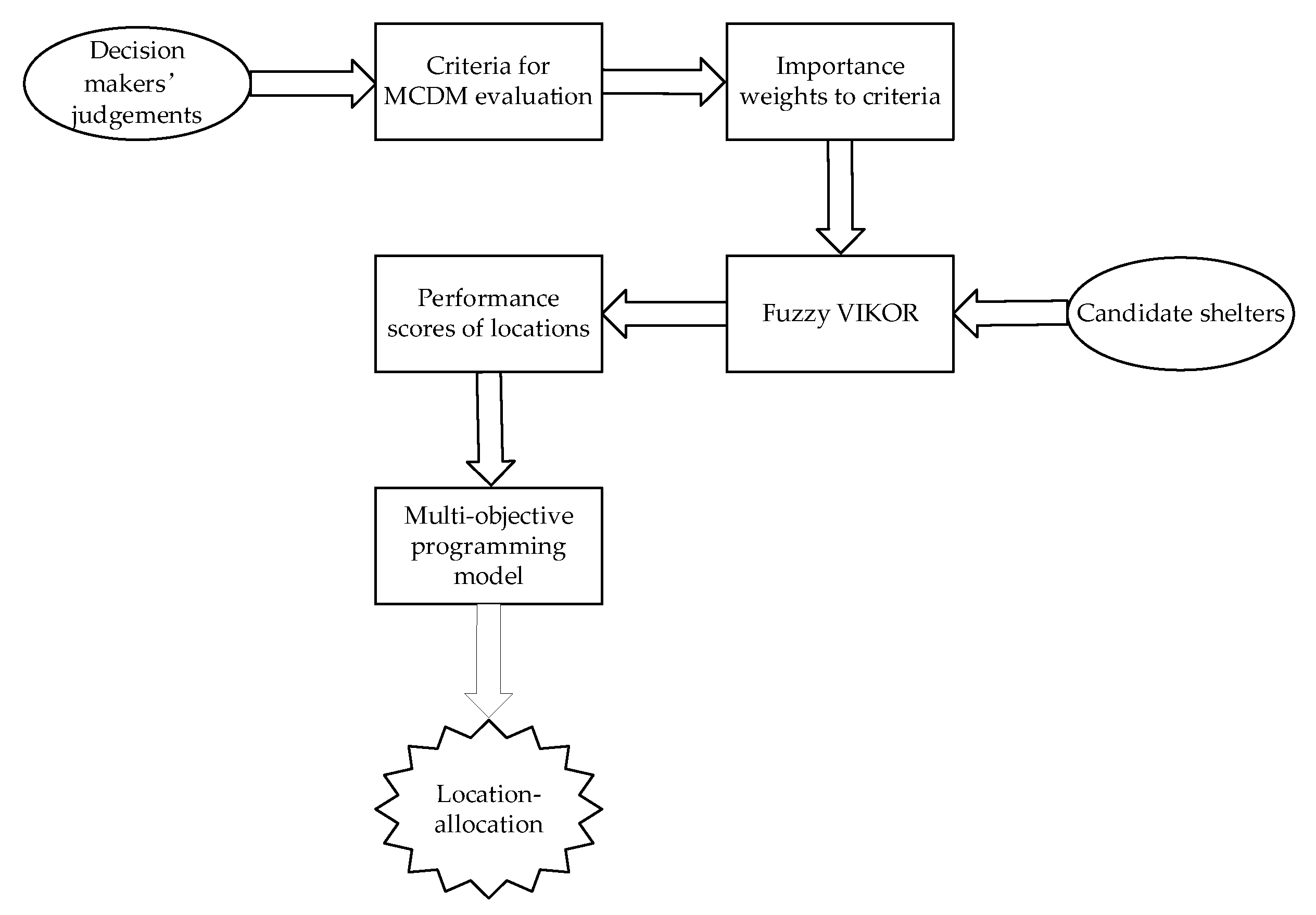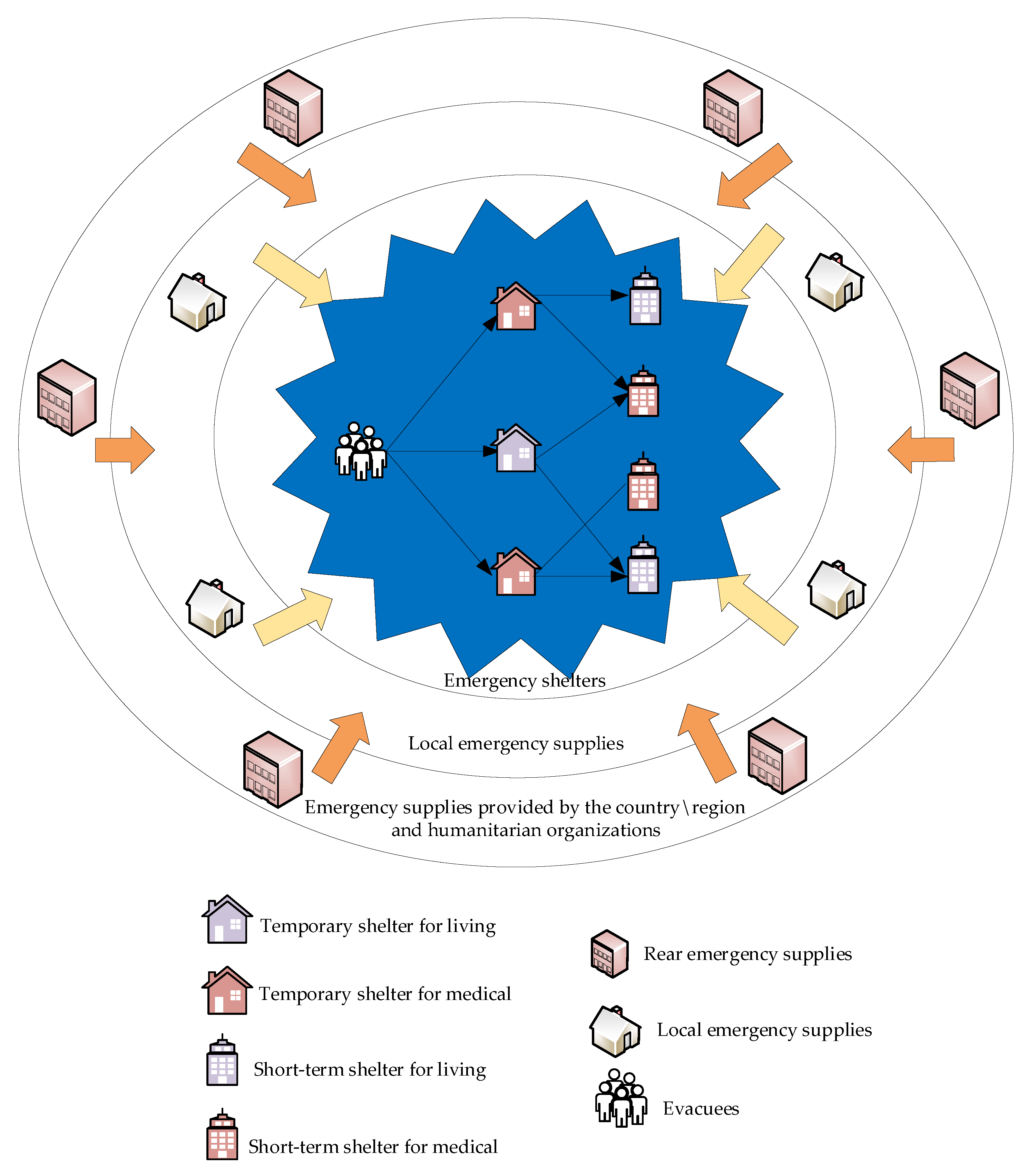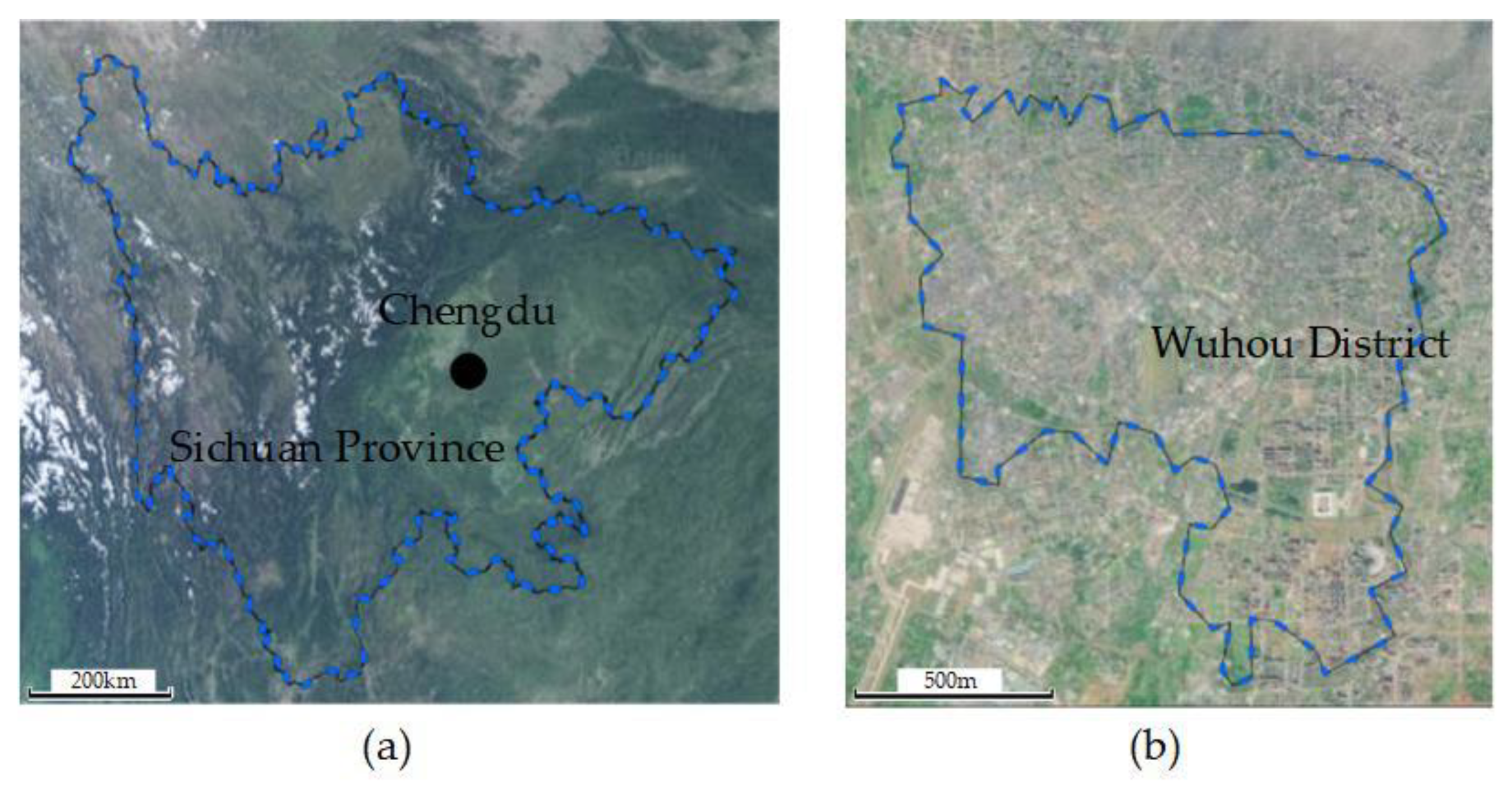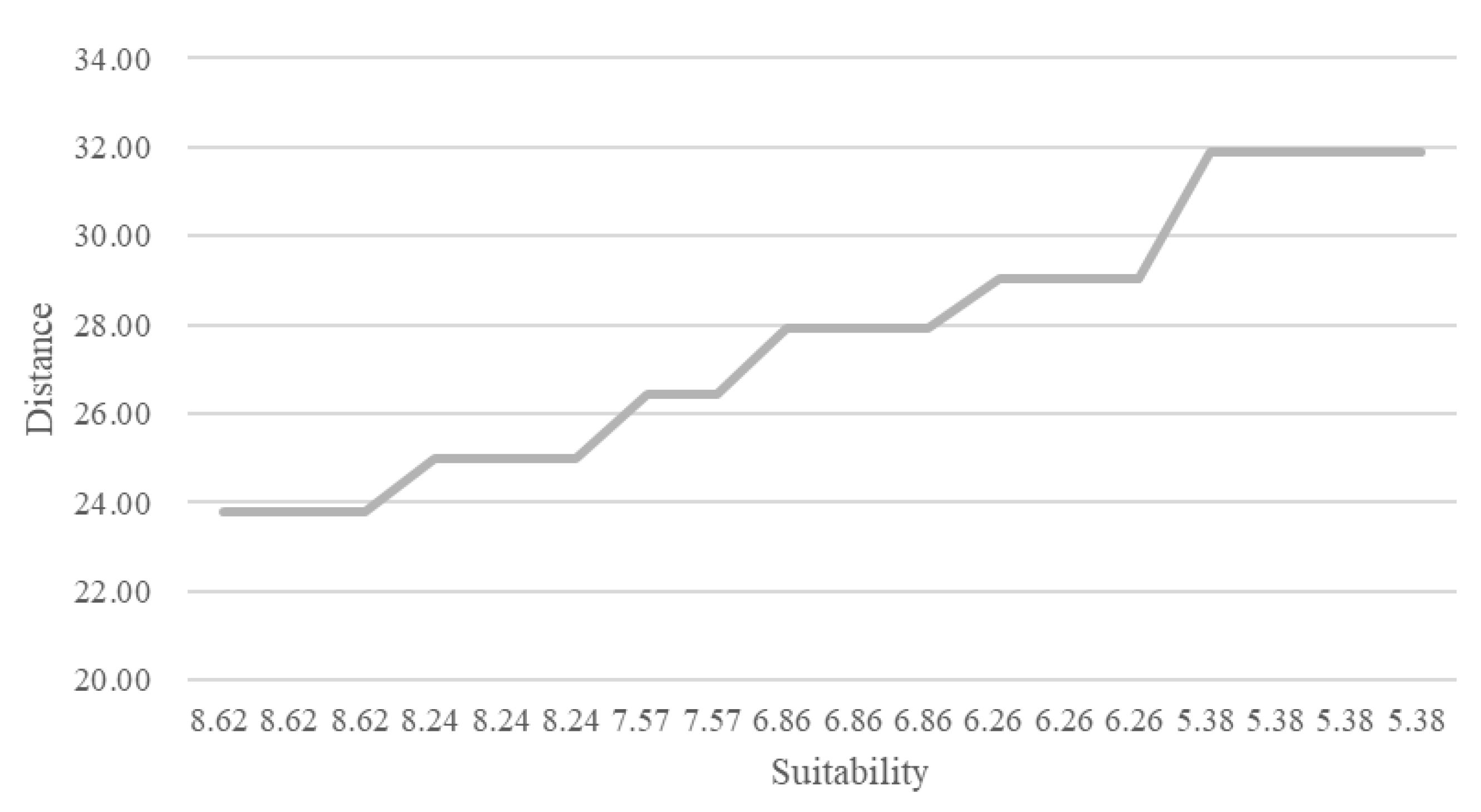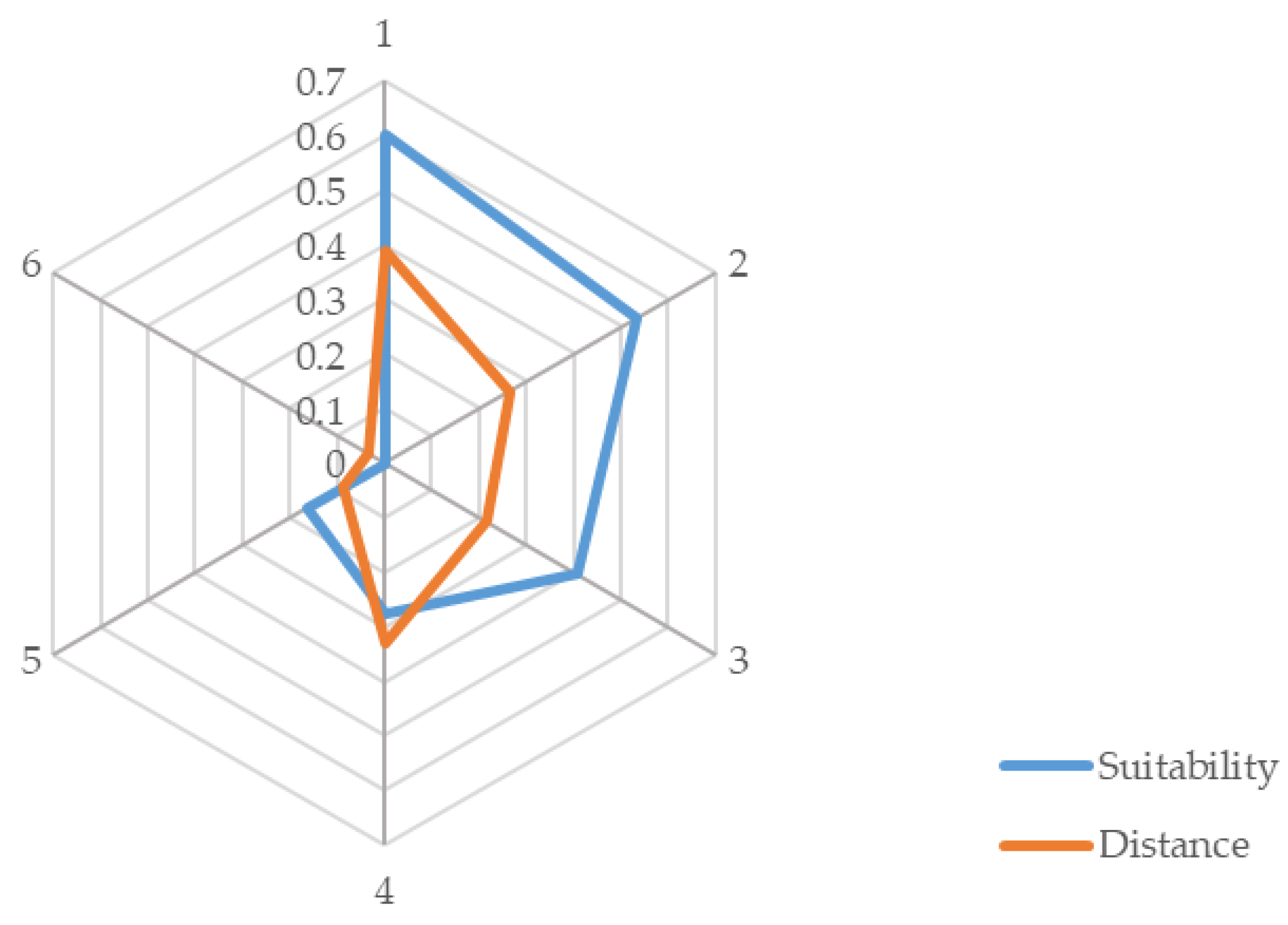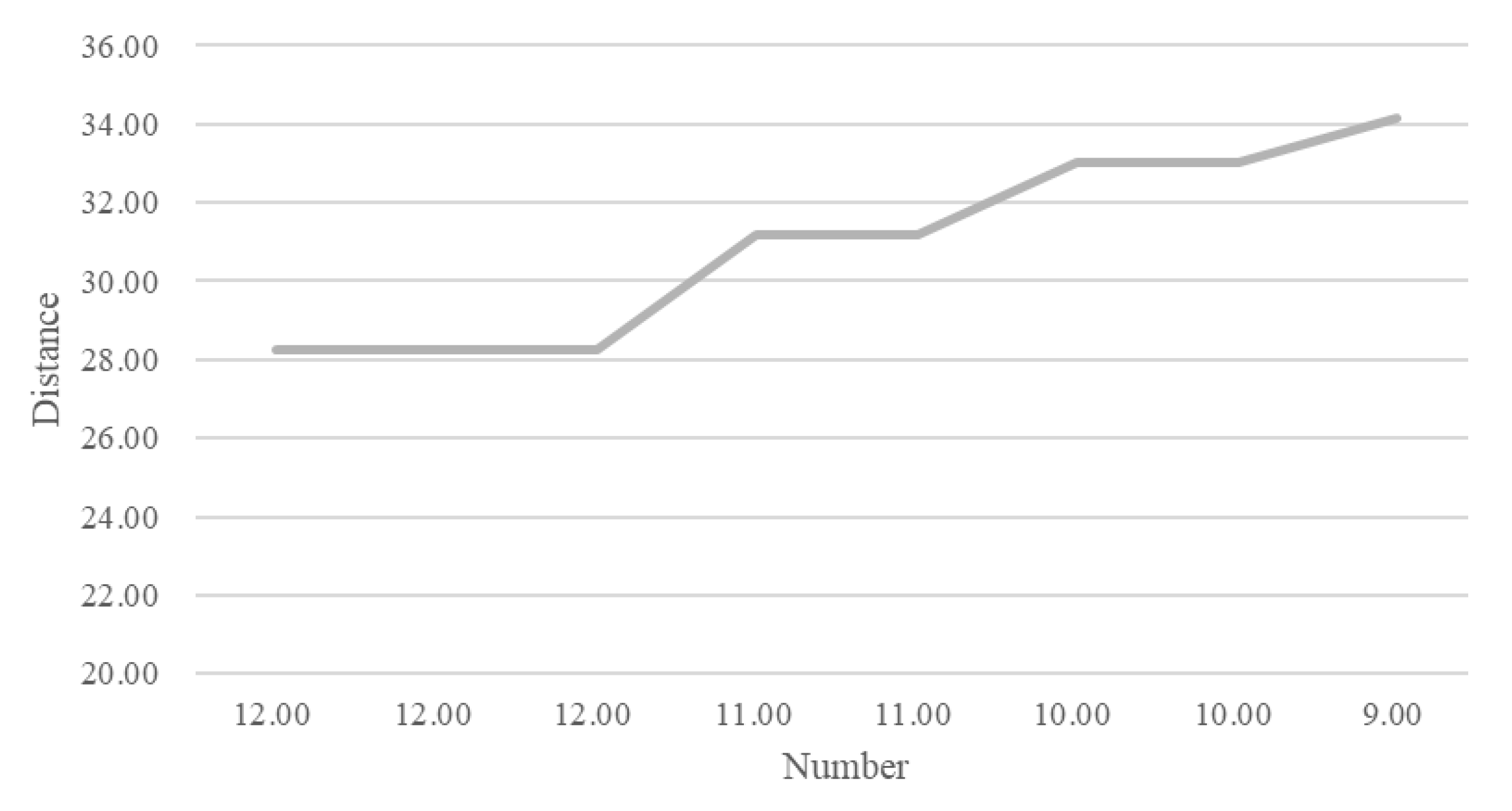1. Introduction
From 1998 to 2017, all disasters worldwide were estimated to have caused 1.3 million deaths and 4.4 billion injuries [
1]. The economic losses totaled USD 2.9 trillion, which was an increase of 2.2 times over the previous 20 years. These facts confirm that although science, technology, and management have advanced, in some cases, they have not been able to significantly decrease the number and impacts of disasters. Earthquake emergency shelters are safe places with service facilities, which can be used for the evacuation and living of residents [
2]. Hence, constructing emergency shelters with reasonable locations is essential to provide safe places with sufficient supplies for evacuees with different demands at different stages of an earthquake.
The role of shelters is fundamental to two types of affected populations: those who cannot be directed to other safe places, and those with special requirements such as life, medical, and psychological treatment [
3]. After an earthquake occurs, the environment is complex and changeable, and the evacuation of life is the disaster management operation that takes the longest time and involves the most links across the entire process. The shelter location–allocation process should not only consider the horizontal and diverse demands of evacuees, provide minimum living and medical security, but also that the medical conditions and environment of the shelter should be gradually improved over time to meet the vertical upgrade demands. Disaster rescue is initiated in a dynamic environment involving a high degree of uncertainty and risk due to the accumulation of many factors. In an unconventional environment, humanitarian aid organizations must deal with multiple conflicting goals based on unavailable and incomplete information. One of the major goals of disaster response activities is to ensure that the affected population is allocated to a safe area and has easy access to basic rescue services. Moreover, the quality of disaster response activities depends to a large extent on the degree of safety and convenience provided to the evacuees. The location of facilities and the distribution of people and materials have been extensively and individually studied in the general logistics context [
4,
5], but rarely analyzed in the context of disaster management. In the present research work, we combine the horizontal diversification and vertical time-varying demands of evacuees in emergency shelter location–allocation decisions and consider both the quantitative and qualitative factors. A hybrid method based on fuzzy-VIKOR and bi-objective programming model is proposed to solve the problems of emergency shelter location, evacuation and transfer of victims, and material distribution to improve the efficiency of post-disaster rescue projects. This method can realize a trade-off between the operating efficiency and cost of the emergency shelter system.
The rest of this manuscript is structured as follows.
Section 2 provides a literature review on the research issue.
Section 3 explains the adopted methodologies while
Section 4 presents the problem for study along with the proposed mathematical model.
Section 5 provides details on the description of the zone to which the models were applied. The efficiency of the model in a case study and the results are further discussed in
Section 6. The last section provides the concluding remarks and future research suggestions.
2. Literature Review
Shelters are important facilities for the allocation of victims after earthquakes. The location of shelters is related to the efficiency of disaster relief and the level of living conditions. Many scholars have conducted a lot of research in this area. Shelter location belongs to the category of emergency facility location. Toregas et al. proposed the location of emergency facilities and simplified it to cover each demand node with one facility [
6,
7]. Most articles reflect the efficiency and response quality of emergency rescue systems through distance, time, or cost, and determine the quality, quantity, and service scope of the facilities. The P-median model minimizes the sum of the product of the distance between demand points and selected P facilities and the demand [
8]. The P-center model minimizes the maximum distance from any demand point to the closest facility to the demand points [
9]. For some residents whose demands are known, the collective coverage model covers all demand points by determining the minimum number of service facilities. Not only is the fairness and service capacity of rescue services met, but they can also be used for managers to make decisions that meet the actual demands based on existing resources [
10]. The goal of this paper was to design an effective response strategy for earthquakes and minimize the casualties of large-scale earthquakes. The collective coverage model can be used to study the problem of emergency shelter location. One of the key assumptions of the collective coverage model is that if the distance between the demand point and the facility is not greater than r, the demand point is assumed to be completely covered, otherwise, the demand point is not covered [
11]. However, in non-routine projects, it is difficult to accurately predict the integrity of the shelter and whether the victims are willing to go to the recommended shelter. The more realistic assumption is that the farther the shelter is from the residential area, the less demand it can meet. Therefore, this paper adopted the idea of multiple coverage levels proposed by Berman et al. [
12,
13]. A coverage attenuation function is proposed to determine the number and location of shelters so that each demand point has multiple coverage level sets and corresponding coverage radiuses.
Emergency shelters should consider the demands of the affected population and carry out the rapid allocation of victims by the principle of matching resource supply and demand to ensure the lives and safety of the evacuees. Some scholars have focused on the optimization of emergency facilities at different levels from the perspective of resource supply. They realized that a single-level emergency center has the shortcomings of insufficient rescue capabilities, and they need to consider constructing double-level emergency shelters [
14]. Ozkapici et al. further distinguished the functions of emergency facilities, which are conducive to the rapid distribution of materials from different countries or international rescue agencies after a disaster [
15]. However, these studies did not consider the impact of changes in the demands on emergency services. Other scholars have studied the problem of shelter rescue from the perspective of demand. For example, Perez et al. emphasized that the diverse demands of the people should not be ignored after the disaster. In addition to basic living demands, the victims also need medical and psychological aid. Emergency shelters and medical centers are arranged according to different demands, but in the face of the upgrading demands over time, there is still no better solution for how to make further arrangements for the location of shelters. Therefore, some scholars have noted the evacuation and transfer of victims in immediate shelters, short-term shelters, and long-term shelters under the time-varying demands to realize the high-quality living of evacuees [
16]. However, the diverse needs of the affected population at different times after the disaster have failed to attract attention. Hence, to comprehensively and systematically solve the evacuation of people after the disaster, we will deal with the needs of victims in vertical and horizontal stratification. It is necessary to consider the vertical and time-varying demands as well as the horizontal and diversified demands in various periods. In response to vertical time-varying demands, the multi-stage optimization of different objectives in two stages has been used to improve the quality of life. For the horizontal and diversified demands of evacuees at various times, shelters can be divided into two types. One type of shelter only provides basic living services, and the other type provides medical or psychological aid.
At present, many studies assume that the function of shelters is mainly to provide safe areas. The proposed models optimize the layout of shelters and the allocation of victims to improve the overall evacuation efficiency [
17,
18]. After the resettlement of victims, the supply of materials is less considered. Evacuation strategies should consider comprehensive problems such as the stratification type, use time, and material distribution due to the uncertainty of demand points, which are unbalanced spatial layouts. Existing research has focused on the location of shelters and emergency resource management [
19,
20]. Shelters can store supplies on their premises or in supermarkets and health care units around shelters to ensure the supply of emergency materials in the short-term and meet the minimum survival demands of the affected population [
21,
22]. However, these studies have paid more attention to the allocation of resources for supply–demand but have ignored the horizontal and vertical stratification on the demand side, which makes it difficult to effectively match the supply and demand. Thomas and Kopczak proposed, from the perspective of humanitarian logistics, to plan, implement, and control the flow and storage of resources from the supply point to the demand point to alleviate the suffering of vulnerable groups [
23]. Sheu et al. optimized the shelter network, medical network, and material distribution network by the time sequence, and proposed the importance of integrating the three sub-networks of disaster management, indicating that the selected shelters should fully consider the demands of victims, medical care, and supply distribution [
24]. Some scholars have also considered the medical supply distribution center and the location of patients after the disaster and the severity of patients under limited budget to determine the temporary medical shelter location [
18]. It reveals the relationship between the selected shelter site, the demands of the patients, and the distribution of supplies, and further explains the impact of demand and distribution on the shelter location.
Decision-making in emergency shelter location–allocation is a complex task, and there are conflicting trade-offs between different criteria (see
Section 3.1.1 for details). The variability of perceptions of different stakeholders between relief organizations often vary, and the existence of differences in disaster scales is normal [
25]. Tools and techniques that can deal with such complex issues and make decisions are needed. Multi-criteria decision-making (MCDM) is a method to help the individual or group of decision-makers to make appropriate and transparent decisions in complex situations. It has been widely used in the fields of social sciences, engineering, health care, and management [
26,
27,
28]. There are many MCDM methods in the literature such as ELECTRE [
29], PROMETHEE [
30], TOPSIS [
31], AHP [
32], COMET [
33], and VIKOR [
34]. MCDM methods can be divided into two steps. In the first step, information related to the value and weight of the criteria needs to be obtained, and then in the second step, the ranking of the alternative is determined. Some studies have illustrated the application of the MCDM method in emergency rescue assessment and intervention strategies. Haldar et al. proposed a quantitative method for strategic supplier selection in a fuzzy environment after the disaster. It ranks suppliers based on the fuzzy decision-making technology of the ideal solution similarity ranking and the fuzzy comprehensive weight to reduce the fragility of the supply chain system [
35]. Trivedi and Singh applied the fuzzy logic-based AHP method for evaluating emergency facilities in a disaster recovery program in the Gorkha district in Nepal [
36]. Malekpoor et al. implemented the VIKOR method to conduct a performance evaluation of technologies such as fuel generators, wind turbines, and solar panels in disaster relief camps to prioritize the generation systems that performed favorably. An application of the fuzzy-VIKOR method for the tailored disaster relief blood supply chain was also presented [
37]. In addition, studies have used ELECTRE and TOPSIS to solve the problems of floor disaster risk, or to rank the regional disaster risk [
38].
As above-mentioned, there are many MCDM approaches to solving decision-making problems. Different types of MCDM methods have been adopted for different types of decision-making problems. The task of choosing the right method is difficult. There are several ways to choose a particular MCDM approach and may be based on the input required information such as data and the parameters of the method [
39,
40]. For our question, we wanted a complete ranking and evaluation score of the criteria and candidate shelters. Methods such as ELECTRE, PROMETHEE, AHP, TOPSIS, COMET, and VIKOR are used to obtain such outcomes. In the calculation process of AHP and COMET, experts are required to make corresponding scores for the comparison between component factors or characteristic targets. When the target has a relatively large number of influencing factors, experts need to judge the importance of a large number of two factors, which may cause difficulty in judging the importance of the two factors. Additionally, COPRAS is a step-by-step ranking and estimation based on the importance and utility of decision attributes. It is usually applied to the ranking and selection of decision-making schemes with multiple criteria and their relative importance is known [
41]. However, many factors influence the decision-making of emergency shelter location–allocation, and it is necessary to provide a trade-off between various standards, that is, to allow a compromise between various standards. Hence, AHP, COMET, and COPRAS approaches were not used in this article. Among the remaining four MCDM methods, ELECTRE and PROMETHEE are methods of the relational model. They start from the priority order between attributes, using higher levels than relationships or priority functions to prioritize, sort, or classify solutions, while TOPSIS and VIKOR belong to the functional model decision-making methods. In fact, after an earthquake, the environment is complex and changeable, and it is difficult for decision-makers to provide a preference order with sufficient reason. TOPSIS and VIKOR methods are more suitable for evaluating the performance of candidate shelters. However, the working principles of TOPSIS and VIKOR are slightly different. TOPSIS is based on aggregate functions that represent close to the ideal. In TOPSIS, the selected alternative should be the shortest distance from the ideal solution and the farthest from the negative ideal solution. The TOPSIS method introduces two reference points, but does not consider the relative importance of the distance to these points [
42]. Opricovic proposed the VIKOR method for the shortcomings of TOPSIS [
34,
43]. The advantage of this method is that the distance between each solution and the ideal solution and the negative ideal solution can be considered at the same time, so that the selected best solution is the closest to the ideal solution and the farthest to the negative ideal solution. Hence, the VIKOR method can find the best solution better than the multi-criteria decision-making method, which only considers the ideal solution and was adopted in this study to evaluate the criteria and potential shelter locations. Moreover, MCDM uses different methods in the fuzzy environment to help make the best decision such as triangular fuzzy numbers [
44,
45], hesitant fuzzy numbers [
46,
47], and linguistic fuzzy sets [
48]. The application of fuzzy set theory provides a suitable solution for multi-objective decision-making problems in uncertain environments. Disaster rescue decisions are made under limited and incomplete information. Fuzzy sets can easily describe the uncertainty that exists after a disaster. Therefore, it is of great significance to combine fuzzy sets with the VIKOR method to analyze and process inaccurate information.
4. Problem Description
In the emergency shelter rescue network, shelters of various scales play different roles. Regardless of the length of time of the evacuation of life, an evacuation place that meets the daily and medical demands should be provided. Temporary shelters are the main resettlement locations after an earthquake to provide one-day emergency services. Afterward, the evacuation environment of short-term shelters gradually improves to provide better services. In addition to maintaining the basic living conditions of the evacuees, medical emergency shelters also play a role in the timely diagnosis and treatment of injuries. To quickly and accurately provide supplies to evacuees, the planning strategy of emergency shelters should be matched with the local materials distribution system. After the evacuation of life is stable, the supplies provided by the country/region or humanitarian organizations arrive in the affected area to eliminate the demand gap in the first stage.
Figure 2 depicts a schematic review of the emergency shelter rescue.
In the manuscript, we propose a model that combines the performance evaluation results obtained by fuzzy-VIKOR with a two-stage bi-objective programming model. The model aims to provide living and medical services for evacuees by considering different types of emergency shelters.
The multi-level coverage idea proposed by Berman and Krass has been adopted to construct the boundary coverage function [
12]. As the distance between emergency shelter
i and affected area
j increases, the proportion of evacuation demand from demand point
j to shelter
i decreases. Suppose the distance relationship between two points is
,
is the maximum evacuation distance set by the local government. The evacuation demand of demand point
j is
.
represents the proportion of demand that can be covered by the distance between the demand point and the emergency shelter in the interval
. The total demand of point
j that can be covered is
, where
. The specific situation of the boundary coverage function is shown in
Figure 3. It is assumed that effective coverage can be divided into three levels. The demands of the affected points 1 and 2 are
and
, respectively. For example, the emergency shelters P1 and P2 located in the first and second layers can cover, at most, the demand of affected point 1 of
.
Table 3 shows the parameters in the multi-objective programming model.
4.1. Temporary Stage of the Model
The first objective function (16) aims to maximize the share of the highest-ranked emergency shelter. The evaluation by fuzzy-VIKOR gives us the coefficients of the objective function design variable. In the second objective function (17), the distance travelled by evacuees and delivered by materials is minimized. and are the normalization of the distance and , when is the maximum and when is the minimum. Formally defined as: , where and are the maximum distance in the matrix. Equation (18) ensures that victims in need of shelter receive it. Equations (19)–(22) ensure that evacuees can be distributed more than the minimum proportion of materials. Equations (23) and (24) state that the number of evacuees assigned to a shelter should not exceed its capacity. Equation (25) maintains that the number of supplies delivered to evacuees should not exceed the capacity of the distribution centers. Equation (26) ensures that each emergency shelter is associated with only one type. Equation (27) is a boundary cover function that limits the number of evacuees that can be allocated to shelters in the kth coverage level of the demand point j. Equation (28) limits the expenses on shelters within the available budget. Equations (29) and (30) define the decision variables.
4.2. Short-Term Stage of the Model
After the first day of being allocated in the temporary shelters, the evacuees have initially grasped the disaster situation. Their physical conditions change and they will be reallocated to different types of short-term emergency shelters. The emergency facilities of short-term shelters are more complete to meet the needs of longer evacuation and living. The suitability of emergency shelters at the short-term stage is not the main purpose, but to reduce the rescue costs.
Equation (31) aims to minimize the distance travelled by the evacuees and delivery of the materials. It is worth noting that the candidate set of short-term living shelters consists of unchosen candidate shelters and temporary living shelters and the candidate set of short-term medical shelters is composed of unselected candidate shelters and temporary medical shelters. Equation (32) aims to minimize the number of short-term shelters to be open, which express minimizing the total shelter construction investment. Equations (33) and (34) restrict all evacuees to be assigned to corresponding shelters. Equations (35)–(38) ensure that the minimum material requirements of evacuees are met. Equations (39) and (40) limit the number of supplies the warehouse provides to capacity. Equation (41) ensures that the warehouse does not exceed its capacity for emergency supplies. Equation (42) indicates that only one type of short-term shelter can be chosen. Equation (43) is the boundary cover function. Equations (44)–(47) indicate various evacuation demands in temporary emergency shelters at the end of the first stage. Equation (48) limits the cost of shelters to existing budgets. Equations (49) and (50) define the decision variables.
